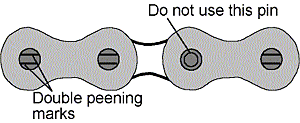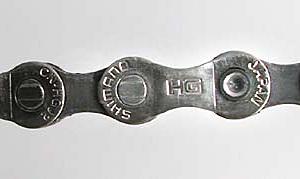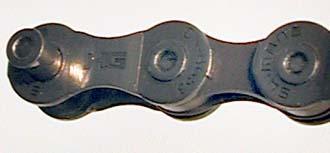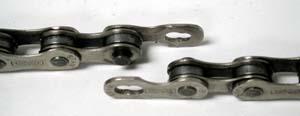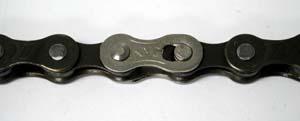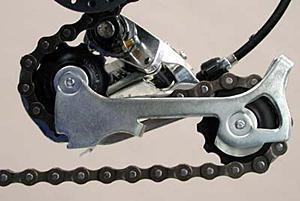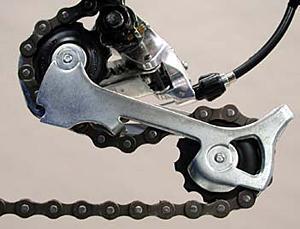

Removing and Installing Derailler ChainLevel of Difficulty: Novice Typical tools & supplies [1]
This article will discuss the removal and installation of chain on derailleur bicycles. See also related articles: Chain construction
Chains are made up of a repeating series of inner plates, a roller, a chain rivet (also call a "pin"), and outer plates. The chain rivet presses into both outer plates, but the rivet slides freely through the inner plates and the roller. Chains have a small amount of play at each link, even when brand new. As a chain is ridden, it wears the rivets, and the play at each link increases. This is sometimes called "stretch", although the plates do not literally become longer. A worn chain will not engage the cogs correctly, and will eventually slip over the cog teeth when pressure is applied. To check chain wear, use the CC-2 Chain Checker. New chains can be fitted to the bicycle, although new chains are longer than required and must be shorted to the correct length. |
||||
|
||||
|
||||
|
||||
|
|
||||
|
|
|
1) Select a chain rivet that has peening marks. These may be either double peening marks (two parallel marks at rivet ends), or a peening completely around the rivet. Avoid selecting the special replacement rivet, and avoid any rivet that looks different from the others. |
|
|
|
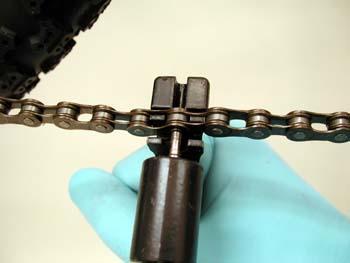 b)
Place the roller of the chain fully in the primary cradle of the chain
tool.
b)
Place the roller of the chain fully in the primary cradle of the chain
tool.
c) Turn the chain tool pin until it contacts chain rivet and stop.
Note position on handle.
d) For most non Park Tool brand chain tools, turn handle 5 complete turns. Use care not to drive out chain rivet. For Park Tool CT-3, drive T-handle until it is stopped by C-clip. For Park Tool CT-5, drive T-handle until body stops screw.
e) Back out chain tool pin and lift chain out of cradle.
f). Grab chain on either side of protruding rivet.
Flex chain toward the protruding chain rivet then pull on chain to separate.
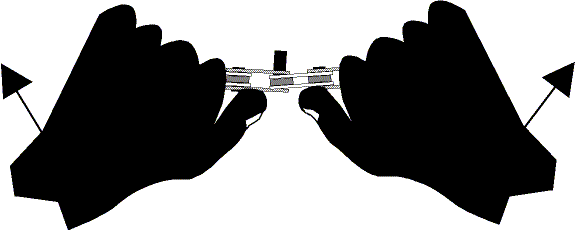
g) Pull on non-rivet end to remove chain from bicycle.
To reinstall the special replacement rivet
a) Reinstall chain on bike with protruding chain rivet facing away from you.
b) Open outer plates slightly and insert inner plates. Align protruding rivet with hole in inner plate.
c) Install special ShimanoŽ replacement rivet into chain rivet hole, with tapered end first. Replacement rivet will protrude outward toward you.
d) Back chain tool pin into tool body to make room for replacement chain rivet.
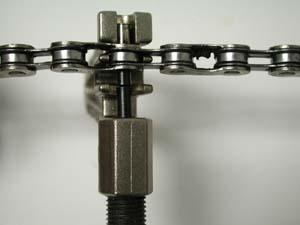 e)
Place roller into primary cradle of chain tool.
e)
Place roller into primary cradle of chain tool.
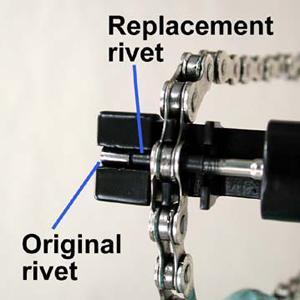 f)
Drive replacement rivet into chain. Replacement rivet will drive out original
rivet. Continue to drive until chain tool pin is almost adjacent to outer
side plate.
f)
Drive replacement rivet into chain. Replacement rivet will drive out original
rivet. Continue to drive until chain tool pin is almost adjacent to outer
side plate.
g) Remove the chain from tool and inspect rivet. Non-tapered end of
replacement rivet should protrude same as any neighboring rivet. As mentioned
above, an insufficiently driven rivet is a possible
failure. Press further if necessary.
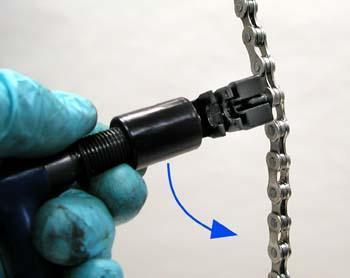 h)
Break off pilot of replacement rivet. With Park Tool, use groove of body
of CT-3
or CT-5
and twist pilot sideways. Pliers can also be used to break rivet. Inspect
rivet again and press further if necessary.
h)
Break off pilot of replacement rivet. With Park Tool, use groove of body
of CT-3
or CT-5
and twist pilot sideways. Pliers can also be used to break rivet. Inspect
rivet again and press further if necessary.
i) The replacement chain rivet should not be used again to separate
the chain. Re-using same rivet hole wears plate holes and may weaken chain.
Use other original rivets for future chain cutting.
j) Inspect for tight links and repair as necessary. See Tight Link Repair.
Conventional Chain
There are several brands of chain that are serviced by pressing out a rivet partially, then re-pressing the same rivet to re-install. Check with the manufacturer's literature when in doubt.
a) Inspect chain for "master link", if any. Disengage master link according to manufacturer's instructions.
b) If no master link is present, place a roller of the chain fully in the primary cradle of the chain tool.
c) Drive chain-tool pin until it contacts chain rivet.
d) For most non Park Tool brand chain tools, turn handle 5 complete turns. Use care not to drive out chain rivet. For Park Tool CT-3, drive T-handle until it is stopped by C-clip. For Park Tool CT-5, drive T-handle until body stops screw.
e) Back out chain-tool pin and lift chain out of cradle.
f) Grab chain on either side of protruding rivet. Flex chain toward the protruding chain rivet then pull on chain to separate.
g) Remove from bicycle by pulling on rivet end of chain.
To reinstall the chain rivet:
a) Re-install chain on bike with protruding rivet facing toward mechanic.
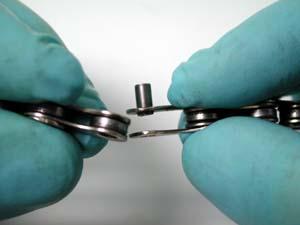 b)
Open empty outer plates slightly and insert inner plates. Push inner
plates until hole aligns with chain rivet.
b)
Open empty outer plates slightly and insert inner plates. Push inner
plates until hole aligns with chain rivet.
c) Back chain-tool-pin into tool body to make room for chain rivet.
d) Place roller into primary cradle with chain rivet facing chain tool pin.
e) Drive chain rivet back into chain, taking care to center rivet exactly between both outer plates. If more chain rivet appears on one side of outer plate than other, push rivet until it is evenly spaced.
f) Inspect for tight links and repair as necessary. See Tight Link Repair.
Master-Links in Derailleur Chains
|
|
|
|
Some chain manufacturers offer a "master-link" to join the chain. Be sure to read the manufacturer's directions. Typically, the bicycle chain ends must have inner plates on each end. In other words, neither chain end has an outer plate with a rivet. The link comes in two pieces.
Install one piece through inside face of chain, and install second piece through outside of the other chain end. Engage the two pieces so link rivet mates to link plate hole. Pull chain to lock the link. The best method to do this is to move master link to top section between rear cogs and front chainrings and press hard on pedals. This insures the link is fully locked. Inspect link before riding the chain.
Note: Some models are reusable, while others are disposable and should be replaced after each removal.
Campagnolo® 10-speed Chains
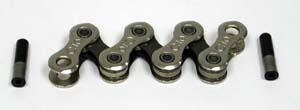 These
chains currently use a special system called the HD-Link. It consists
of a short section of links and two special piloted rivets. When determining
chain length, you must deduct an additional amount of chain equal to this
section.
These
chains currently use a special system called the HD-Link. It consists
of a short section of links and two special piloted rivets. When determining
chain length, you must deduct an additional amount of chain equal to this
section.
Both ends of the special link section are out plates, and these must attach
to the inner plate section of the chain. Install the pilot into the chain
rivet and place this into the chain. Engage pilot and rivet so that the
rivet faces the inside of the bike, toward the spokes. The pilot is then
pushing outward, away from the spokes.
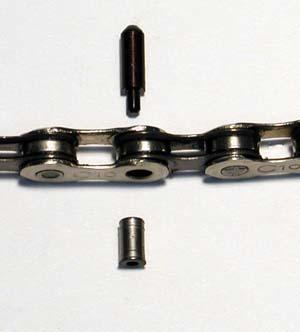
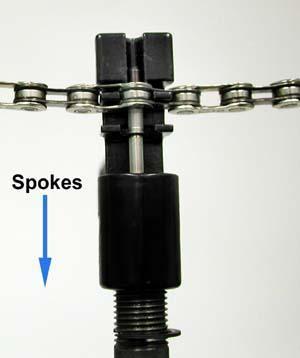
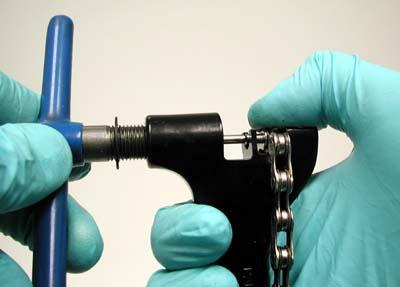 It
is especially important with the Park Tool chain tools to press downward
on the chain at rivet to keep in fully engaged. In the image left, the
thumb presses down on the chain.
It
is especially important with the Park Tool chain tools to press downward
on the chain at rivet to keep in fully engaged. In the image left, the
thumb presses down on the chain.
After the rivet is fully pressed, remove the pilot simply by pulling outward.
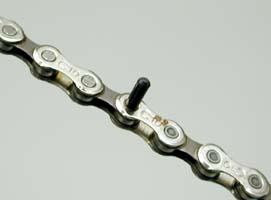
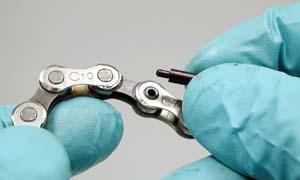
Installing Chain Through Derailleurs
The chain is routed through the rear and front derailleurs before being joined. It is best to first determine chain length before instaling chain.
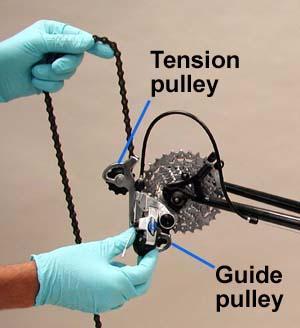 a.
Shift front and rear derailleur under smallest rear cogs.
a.
Shift front and rear derailleur under smallest rear cogs.
b. Pull back on rear derailleur and feed short section of chain over the tension pulley and straight to the guide pulley.
|
|
|
|
NOTE: Double check chain routing between pulleys. Chain should not drag on any part of the derailleur cage. Top image on left shows correct routing. Lower image shows incorrect routing.
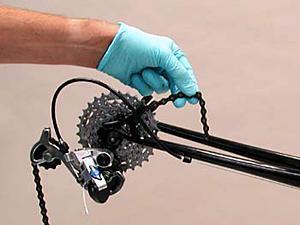 c)
Pull chain behind rear cogs and then foward toward front rings.
c)
Pull chain behind rear cogs and then foward toward front rings.
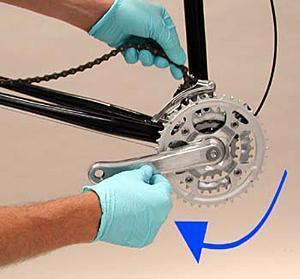 d)
Hold a short section of chain and feed chain through front derailleur
cage. Turn cranks slowly as you feed chain onto smallest ring.
d)
Hold a short section of chain and feed chain through front derailleur
cage. Turn cranks slowly as you feed chain onto smallest ring.
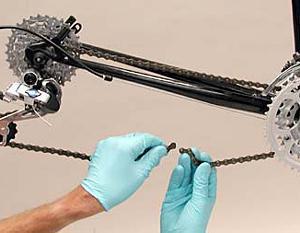 e)
Join chain at lower section between front and rear cogs. Use correct procedure
according to brand of chain. See process above.
e)
Join chain at lower section between front and rear cogs. Use correct procedure
according to brand of chain. See process above.
f) After installing the chain, check for any tight links. Before riding the bike, check the derailleur adjustment.
Suggested Park Tools
- Chain Tools: CT-2, CT-3, CT-5 or tool in MTB-1
- Repair Stand such as PCS-1 or PCS-4



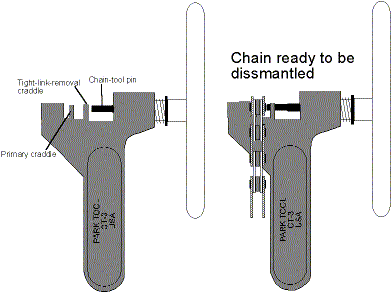 To
install or remove a chain, a chain tool is required. Chain tools are made
up of a driving pin and a cradle to hold the chain-roller. Some models
have two cradles. The primary cradle supports the chain plate for pressing
the chain rivet in and out. The tight link cradle is only for fixing a
To
install or remove a chain, a chain tool is required. Chain tools are made
up of a driving pin and a cradle to hold the chain-roller. Some models
have two cradles. The primary cradle supports the chain plate for pressing
the chain rivet in and out. The tight link cradle is only for fixing a

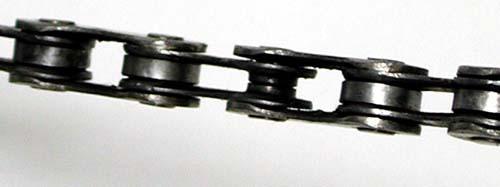
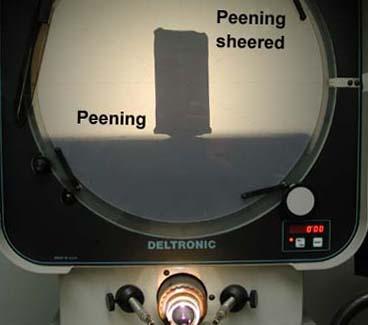 Some
chains, including ShimanoŽ, use chain rivets which are peened. This creates
a "mushroom" effect at the ends of the rivets, which adds to the strength
of the chain side plates. When a rivet is pressed even partically out,
this peening is sheered off on the side pressed by the chain tool. If
this rivet were reused, it would create a weak link at that rivet. In
the image below, a ShimanoŽ rivet is shown in an optical comparator, which
magnifies the rivet. The original peening is seen at the bottom of the
rivet. The top of rivet has the peening sheered off. This top section
was pushed through the outer chain plate.
Some
chains, including ShimanoŽ, use chain rivets which are peened. This creates
a "mushroom" effect at the ends of the rivets, which adds to the strength
of the chain side plates. When a rivet is pressed even partically out,
this peening is sheered off on the side pressed by the chain tool. If
this rivet were reused, it would create a weak link at that rivet. In
the image below, a ShimanoŽ rivet is shown in an optical comparator, which
magnifies the rivet. The original peening is seen at the bottom of the
rivet. The top of rivet has the peening sheered off. This top section
was pushed through the outer chain plate.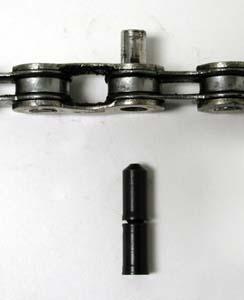 ShimanoŽ
chains use a special replacement rivet when the chain is installed new
or when one is removed and re-installed. This replacement rivet has special
flaring that is guided in by a long tapered pilot. The pilot is then broken
off before riding. Only ShimanoŽ brand chains should use the ShimanoŽ
replacement rivet. The 7 and 8 speed chains use a black rivet. The narrower
9 speed chain uses a silver-colored rivet.
ShimanoŽ
chains use a special replacement rivet when the chain is installed new
or when one is removed and re-installed. This replacement rivet has special
flaring that is guided in by a long tapered pilot. The pilot is then broken
off before riding. Only ShimanoŽ brand chains should use the ShimanoŽ
replacement rivet. The 7 and 8 speed chains use a black rivet. The narrower
9 speed chain uses a silver-colored rivet.